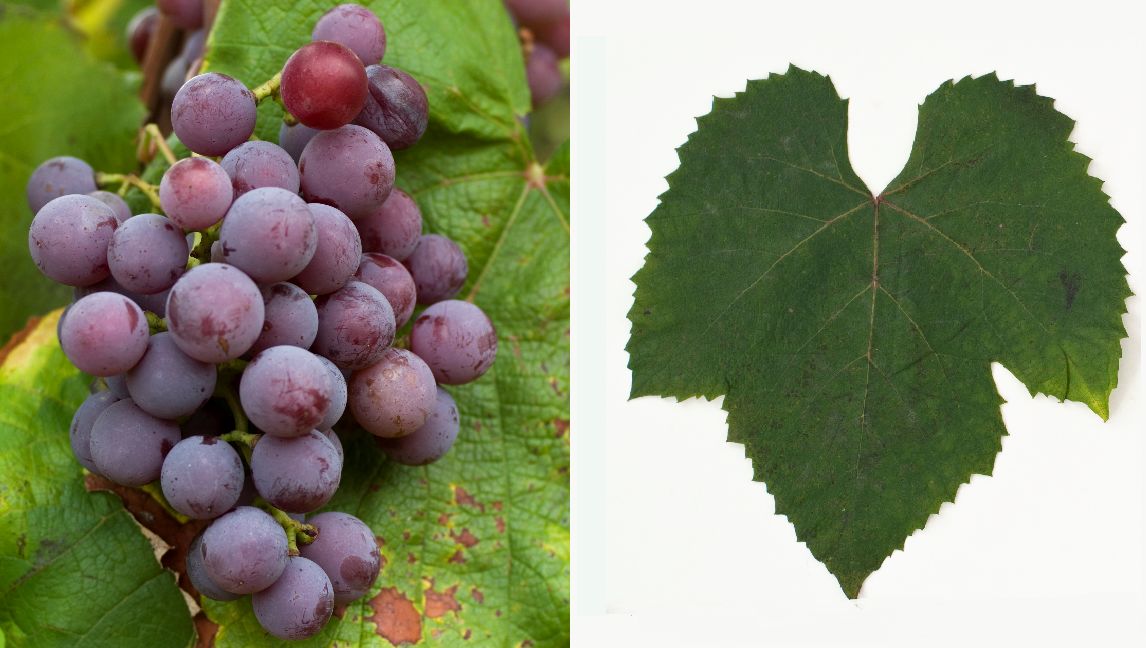The red grape variety originates from the USA; it is named after the river of the same name in North Carolina or Sioux Indian tribe. Synonyms are Arkansas, Catalan, Catalan Rojo, Catalan Roxo, Catawba Rosa, Cher Kee, Cherokee, Fanches, Francher, Francher Kello White, Francher Kells White, Lebanon, Lebanon Seedling, Lichigan, Lincoln, Mammoth Catawba, Meads Seedling, Mecleron, Merceron, Michigan, Muncy, Muncy Pale Red, Munipale Red, Omega, Red Muncy, Rose of Tennessee, Red Capraube, Saratoga, Singleton, Tekomah, Tokay and Virginia Amber. Along with Concord, Norton and Scuppernong, it is one of the most important American vines. The botanist Liberty Hyde Bailey (1858-1954) called the Catawba grape "the first great American grape". The variety's parentage was unclear for a long time, or rather there were several partly contradictory conjectures. The parentage was only determined in 2016 at the Julius Kühn Institute (Geilweilerhof) by DNA analysis. The variety comes from a cross between a wild Vitis labrusca (which was always suspected to be the parent) x Sémillon. It may well be a deliberately induced cross or a new variety. Furthermore, it turned out that Catawba is a parent of the famous Concord. Catawba was also a crossing partner of the new variety Woodruff. The varieties Catawba White, Diana (3) and To Kalon are open-pollinated seedlings.

In 1801, some wild vines were discovered by the innkeeper Samuel Murray (1739-1817) near Ashville in North Carolina. Some cuttings came into the possession of Senator General Davy in 1807, who planted them on his property at Rocky Mount near the Catawba River, naming them first Tokay and later after the river. He sent some specimens to friends in Maryland. Some of them came into the possession of the surveyor Major John Adlum (1759-1836). He planted them in 1820 on his vineyard "The Vineyard" in Georgestown (in the District of Washington, DC) and produced the first wine from them two years later. In 1823, Adlum sent a bottle of wine made from it to former US President Thomas Jefferson (1743-1826), who expressed his appreciation in a letter of thanks.
Finally, in 1825, the lawyer Nicholas Longworth (1783-1863) received Catawba cuttings from Adlum and cultivated them on a large scale on his lands near Cincinnati on the Ohio River in the state of Ohio. In 1842, 480 hectares were already planted with it. Longworth produced the first American sparkling wine "Sparkling Catawba" and became the first large commercial US wine producer. Catawba wine was even successfully exported to Europe. The author Henry Longfellow (1807-1882) praised the wine in a ballad in 1854. However, the American Civil War (1861-1865), vine diseases and finally Longworth's death put an end to these first successes.
The very late-ripening, high-yielding and frost-hardy vine is susceptible to black rot and both types of mildew. It produces wines with high acidity and a discreet Fox tone. However, it is mainly used as a table grape and for sparkling wine, jelly and grape juice. It was the first successful grape variety in the USA long before the famous Concord. However, due to the disadvantage of not being able to produce high-quality dry wines, it experienced a decline. The variety is mainly grown in New York State (480 ha). Other vineyards are in Arkansas, Illinois, Indiana, Iowa, Michigan, Missouri, Pennsylvania and Tennessee. The area under cultivation in the USA is 625 hectares. There is a tiny stand of 0.4 hectares in the Swiss canton of Ticino. In 2016, a total of 626 hectares of vineyard area was reported (Kym Anderson).
Source: Wine Grapes / J. Robinson, J. Harding, J. Vouillamoz / Penguin Books Ltd. 2012
Images: Ursula Brühl, Doris Schneider, Julius Kühn-Institut (JKI)
Voices of our members

The Wine lexicon helps me to keep up to date and refresh my knowledge. Thank you for this Lexicon that will never end in terms of topicality! That's what makes it so exciting to come back often.
Thorsten Rahn
Restaurantleiter, Sommelier, Weindozent und Autor; Dresden